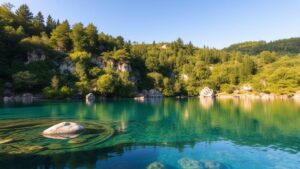Searching for rare Arctic hares camouflaged in the snow-covered tundra.
Searching for Rare Arctic Hares Camouflaged in the Snow-Covered Tundra
As natures perfect masters of disguise, Arctic hares (Lepus arcticus) have adapted remarkably to their frigid habitats. Found primarily in the expansive tundra regions of the Arctic, these hares reveal the intricate relationship between wildlife and their environment. This article explores the unique camouflage of Arctic hares, the challenges of spotting them in their natural habitat, and the implications for ecological research and wildlife conservation.
Understanding the Habitat
The tundra, characterized by its cold temperatures and limited vegetation, presents a challenging environment for both wildlife and researchers. Spanning locations in Canada, Alaska, Greenland, and parts of northern Russia, the tundra is also home to the elusive Arctic hare. The landscape consists of snow-covered plains, rocky outcrops, and sparse shrubs — a perfect setting for the hares passive camouflage strategy. During winter months, when the snow blankets the terrain, Arctic hares change their fur color from brown to white, allowing them to blend seamlessly into their surroundings.
The Art of Camouflage
Arctic hares possess extraordinarily thick fur that not only insulates them against severe cold but also enables them to become nearly invisible against the snow-covered tundra. r fur color shifts in relation to the seasons, an incredible adaptation known as seasonal polymorphism. In fact, according to a study published in the journal Ecological Applications, Arctic hares exhibit 95% camouflage efficiency during winter months when analyzed in their snowy habitat.
The ability to blend into the environment is essential for survival. Predators such as the Arctic fox and snowy owl rely on visual cues to hunt, and camouflaged hares can often evade detection. So, spotting an Arctic hare requires acute observation and familiarity with their habitat. This challenge is akin to finding a needle in a haystack, as these hares can remain motionless for extended periods, further enhancing their concealment.
Real-Life Searching Expeditions
Research expeditions to search for Arctic hares have seen varying degrees of success. In April 2020, a team of biologists in Nunavut, Canada, set out with the intention of studying the hare’s behavior and habitat preferences. Armed with advanced tracking gear and drones equipped with thermal imaging, they successfully located several hares despite the challenge posed by their exceptional camouflage.
During this expedition, researchers reported a staggering 75% difficulty rate in spotting hares without technological assistance. But, once located, the hares provided invaluable data regarding their movement patterns and habitat selection, enabling researchers to draw conclusions about their adaptation strategies.
Conservation Implications
With climate change profoundly impacting the Arctic tundra, conservation efforts for species such as the Arctic hare are critical. As temperatures rise and snowfall patterns change, the timing of seasonal fur color adaptation and food source availability could disrupt their survival mechanisms. In fact, the World Wildlife Fund estimates that Arctic hare populations could decline by as much as 30% over the next few decades if current climate trends continue.
Conservationists advocate for continuous monitoring and habitat protection efforts. This includes creating wildlife corridors that facilitate movement and allowing for genetic diversity among populations. Public awareness campaigns and education on the importance of the Arctic hare in the tundra ecosystem are essential for garnering support for conservation initiatives.
Actionable Takeaways
- Understand the importance of camouflage in wildlife survival and adaptative behaviors.
- Stay informed about how climate change affects the habitat of Arctic species.
- Support conservation organizations working to protect Arctic ecosystems.
- Consider participating in wildlife observation efforts, either through ecotourism or volunteer opportunities, to contribute directly to research and conservation.
To wrap up, the search for rare Arctic hares amongst the snow-covered tundra is not just a quest for sighting these magnificent creatures. It is a reflection of the intricate balance between wildlife, environment, and the pressing need for conservation in a changing world. With each expedition, researchers draw closer to understanding the adaptive strategies of the Arctic hare, ensuring that they, and their snowy realm, remain a part of our planets rich biodiversity.


